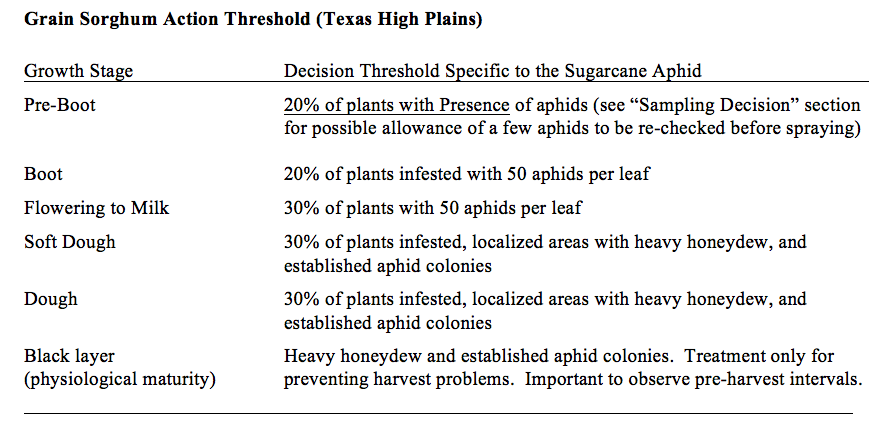This tip was provided by:
This Sorghum Tip from Extension Entomologist Dr. Ed Bynum, Amarillo, directs sorghum growers in the Texas High Plains to AgriLife Extension entomologist guidelines developed for the region. These efforts are coordinated by Dr. Bynum, Amarillo, (806) 677-5600, ebynum@ag.tamu.edu, and Dr. Pat Porter, Lubbock, (806) 746-6101, pporter@ag.tamu.edu in conjunction with the five Extension IPM agents that each cover 2 or 3 counties in the South Plains (based in Lamesa, Brownfield, Levelland, Lubbock, and Plainview)
High Plains
2016 AgriLife Extension Entomology Sugarcane Aphid Information
The March 10 Sorghum Tip summarized sugarcane aphid control recommendations from Dr. Robert Bowling for SCA in South and Central Texas. In this edition, High Plains sorghum growers are directed to a different set of SCA control recommendations for the High Plains region. Compared to South & Central Texas guidelines, the initial action thresholds are lower for the Texas High Plains.
If you have last year’s thresholds on hand in the High Plains, discard them and replace with the information resources below.
Since Dr. Bowling’s update, SCA has been confirmed to have overwintered on Johnsongrass in at least three counties in the High Plains (Dawson, Lubbock, Hale), but IPM agents based in Lamesa & Garden City currently have no reports of SCA on commercial sorghum.
You may access the current statewide AgriLife sugarcane aphid management guide at http://www.texasinsects.org/sorghum.html In addition to information on SCA identification, scouting, and insecticides, note the High Plains specific information found on pages 4-5. These High Plains specific guidelines are also published at http://lubbock.tamu.edu/files/2016/03/ENTO-047.pdf (ENTO-047, “2016 Texas High Plains Sugarcane Aphid Management Guide”; you can get laminated cards from your county Extension office or order from http://agrilifebookstore.org )
Overall Texas High Plains AgriLife Extension entomology suggestions for managing SCA follow these six principles:
Primary Options to Reduce Potential SCA Damage on Grain Sorghum
1) Plant outside the normal window {Early planting, e.g. late April in the South Plains to reduce risk of infestation in whorl stage, late planting in mid-summer will have a higher risk of infestation in whorl stages, but beneficial insect populations may be increasing.}
2) Use seed insecticide treatments. {This might add up to ~$50/bag for seed, but that is still less than $2.50/acre in dryland. Entomologists have noted that you should anticipate at least 30 days of some protection with any of the insecticide seed treatments.}
3) Plant “resistant” hybrids (talk to companies). {All sorghum hybrids are susceptible to SCA at some level, and AgriLife statewide has conducted little research yet on commercial hybrids. (United Sorghum Checkoff Program has summarized a list of what companies believe is their most tolerant material, see http://www.sorghumcheckoff.com/newsroom/2016/03/28/sugarcane-aphid/ )}
4) Spray promptly at threshold. {IPM agent Kerry Siders has noted that a good first shot may eliminate the need for a second spray.}
5) Re-spray the field as needed.
6) Preserve biological control—your best friend.
Additional High Plains SCA management tip sections in ENTO-047 include:
- First Detection: Is the field at risk?
- Sampling Decision
- Control Options after First Application
- Forage Sorghum Management
For further information on sugarcane aphid in the Texas High Plains and beyond follow the online Texas Sugarcane Aphid News at http://txscan.blogspot.com








